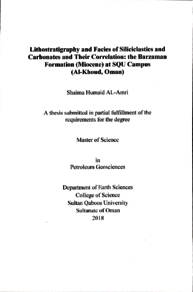Document
Lithostratigraphy and facies of siliciclastics and carbonates and their correlation : the Barzaman Formation (Miocene) at SQU Campus (AI Khoud, Oman).
Publisher
Sultan Qaboos University
Gregorian
2018
Language
English
Subject
English abstract
There are different studies discussing the Barzaman Formation in the UAE and sw Oman while outcrops exposed in North Oman are not studied in detail. The aim of this study is to construct detailed lithostratigraphic columns with correlations and documenting a Miocene syndepositional thrust, instable slope sediments, identifying the depositional environments and studying the diagenesis. The field observations, laboratory microscopic analyses of (25 thin sections) and XRD (X-Ray Diffraction) analyses of 8 samples have been used for the correlation between different logs by recognizing the similarity in lithology, mineralogy, and fossils contents and for determining the depositional environments and the depositional history. The observed thickness of the exposed Barzaman Formation within the SQU campus as represented in the measured sections amounts to 91.3 m, which is not the maximum value for this formation.
By integrating all methods, the Barzaman Formation has been divided into five levels, according to the similarity in lithology and depositional environments. These levels are: the (1) lower conglomerate and sandstone facies, (2) carbonate facies, (3) varied thick sandstone and conglomerate facies, (4) claystone (palygorskite) and conglomerate facies, and (5) dolomitic conglomerate facies.
These different depositional levels of different lithological successions have been deposited in different depositional environments which are in chronological order: (1) shallow marine clastics with tidal inlet, (2) shallow marine coral limestone, (3) shallow marine clastics, (4) lacustrine claystones, associated with fluvial conglomerates and (5) conglomerates of uncertain origin due to intense dolomite cementation. All identified environments represent a landward retrogradational succession.
The levels 2 to 4 were deposited in an arid environment and, hence, before the change towards wet and humid climate during the late Miocene to Pliocene. During the late Miocene to Pliocene the dolomitic conglomerates most likely received their dolomite cement
Other interesting results include an angular unconformity and gravity mass deposits (instable slope deposits): limestone debrite, slide unit, imbricated stacked layers of conglomerate and claystone; all of those and the unconformity) may reflect syndepositional seismicity. There is corresponding evidence for a syndepositional thrust. Furthermore, the observed clay minerals and the dolomite cementation of the dolomitic conglomerates were genetically analyzed and interpreted. Mg-rich ground water led to dolomite cementation of the upper conglomerates layers. Weathering of ophiolite clasts, which represent the dominant clast types of the conglomerates and gravelly sandstones,
Member of
Resource URL
Category
Theses and Dissertations

